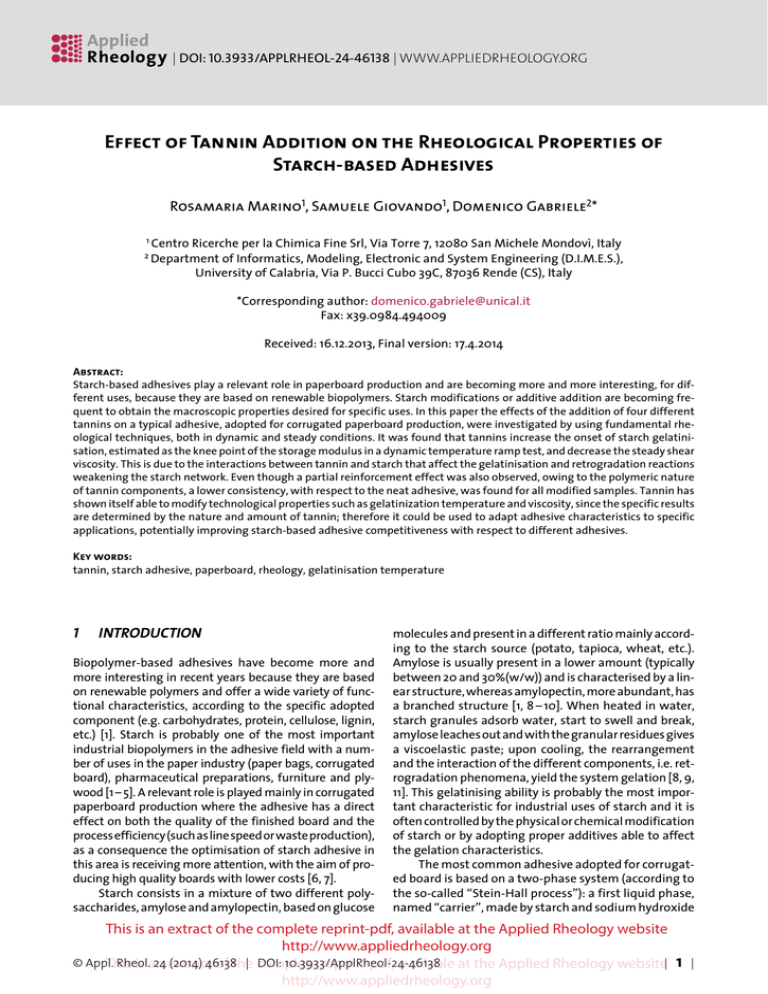Effect of tannin addition on the rheological properties of starch
advertisement

| DOI: 10.3933/APPLRHEOL-24-46138 | WWW.APPLIEDRHEOLOGY.ORG Effect of Tannin Addition on the Rheological Properties of Starch-based Adhesives Rosamaria Marino1, Samuele Giovando1, Domenico Gabriele2* 1 Centro Ricerche per la Chimica Fine Srl, Via Torre 7, 12080 San Michele Mondovì, Italy of Informatics, Modeling, Electronic and System Engineering (D.I.M.E.S.), University of Calabria, Via P. Bucci Cubo 39C, 87036 Rende (CS), Italy 2 Department *Corresponding author: domenico.gabriele@unical.it Fax: x39.0984.494009 Received: 16.12.2013, Final version: 17.4.2014 Abstract: Starch-based adhesives play a relevant role in paperboard production and are becoming more and more interesting, for different uses, because they are based on renewable biopolymers. Starch modifications or additive addition are becoming frequent to obtain the macroscopic properties desired for specific uses. In this paper the effects of the addition of four different tannins on a typical adhesive, adopted for corrugated paperboard production, were investigated by using fundamental rheological techniques, both in dynamic and steady conditions. It was found that tannins increase the onset of starch gelatinisation, estimated as the knee point of the storage modulus in a dynamic temperature ramp test, and decrease the steady shear viscosity. This is due to the interactions between tannin and starch that affect the gelatinisation and retrogradation reactions weakening the starch network. Even though a partial reinforcement effect was also observed, owing to the polymeric nature of tannin components, a lower consistency, with respect to the neat adhesive, was found for all modified samples. Tannin has shown itself able to modify technological properties such as gelatinization temperature and viscosity, since the specific results are determined by the nature and amount of tannin; therefore it could be used to adapt adhesive characteristics to specific applications, potentially improving starch-based adhesive competitiveness with respect to different adhesives. Key words: tannin, starch adhesive, paperboard, rheology, gelatinisation temperature 1 INTRODUCTION Biopolymer-based adhesives have become more and more interesting in recent years because they are based on renewable polymers and offer a wide variety of functional characteristics, according to the specific adopted component (e.g. carbohydrates, protein, cellulose, lignin, etc.) [1]. Starch is probably one of the most important industrial biopolymers in the adhesive field with a number of uses in the paper industry (paper bags, corrugated board), pharmaceutical preparations, furniture and plywood [1 – 5]. A relevant role is played mainly in corrugated paperboard production where the adhesive has a direct effect on both the quality of the finished board and the process efficiency (such as line speed or waste production), as a consequence the optimisation of starch adhesive in this area is receiving more attention, with the aim of producing high quality boards with lower costs [6, 7]. Starch consists in a mixture of two different polysaccharides, amylose and amylopectin, based on glucose molecules and present in a different ratio mainly according to the starch source (potato, tapioca, wheat, etc.). Amylose is usually present in a lower amount (typically between 20 and 30%(w/w)) and is characterised by a linear structure, whereas amylopectin, more abundant, has a branched structure [1, 8 – 10]. When heated in water, starch granules adsorb water, start to swell and break, amylose leaches out and with the granular residues gives a viscoelastic paste; upon cooling, the rearrangement and the interaction of the different components, i.e. retrogradation phenomena, yield the system gelation [8, 9, 11]. This gelatinising ability is probably the most important characteristic for industrial uses of starch and it is often controlled by the physical or chemical modification of starch or by adopting proper additives able to affect the gelation characteristics. The most common adhesive adopted for corrugated board is based on a two-phase system (according to the so-called “Stein-Hall process”): a first liquid phase, named “carrier”, made by starch and sodium hydroxide This is an extract of the complete reprint-pdf, available at the Applied Rheology website http://www.appliedrheology.org © Appl. Rheol. 24 extract (2014) 46138 | complete DOI: 10.3933/ApplRheol-24-46138 This is an of the reprint-pdf, available at the Applied Rheology website| 1 | http://www.appliedrheology.org teristics to specific uses without changing the weight fraction of all the components or the nature of the starch adopted and this could improve the starch-based adhesive competitiveness with respect to different adhesives. ACKNOWLEDGEMENTS Acknowledgments are due to the Laboratory of Rheology and Food Engineering at University of Calabria where the experimental tests were performed. REFERENCES [1] [2] [3] [4] [5] [6] [7] [8] [9] [10] [11] [12] [13] [14] Imam SH, Bilbao-Sainz C, Chiou B-S, Glenn GM, Orts WJ: Biobased adhesives, gums, emulsions, and binders: Current trends and future prospects, J. Adhes. Sci. Technol. 27 (2013) 1972 – 1997. Ashley RJ, Cochrane MA, Allen KW: Adhesives in packaging, Int. J. Adhes. Adhes. 15 (1995) 101 – 108. Moubarik A, Charrier B, Allal A, Charrier F, Pizzi A: Development and optimization of a new formaldehyde-free cornstarch and tannin wood adhesive, Eur. J. Wood Wood Prod. 68 (2009) 167 – 177. Wang Z, Li Z, Gu Z, Hong Y, Cheng L: Preparation, characterization and properties of starch-based wood adhesive, Carbohydr. Polym. 88 (2012) 699 – 706. Liu J, Guo L, Yang L, Liu Z, He C: The Rheological Property of Potato Starch Adhesives, Adv. J. Food Sci. Technol. 6 (2014) 275 – 279. Theel P: Starch and glue revisited, International Paper Board Industry, January 2012 (2012) 50 – 57. Luo P, Liu Y, Zhao X, Song P, Tan N, Sun M: Development of a starch adhesive for corrugated board under room temperature, Adv. Mater. Res. 179-180 (2011) 812 – 817. Jobling S: Improving starch for food and industrial applications, Curr. Opin. Plant Biol. 7 (2004) 210 – 218. Ross-Murphy SB: Structure-property relationships in food biopolymer gels and solutions, J. Rheol. 39 (1995) 1451 – 1463. Schmidt W, Brouwers HJH, Kühne H-C, Meng B: The working mechanism of starch and diutan gum in cementitious and limestone dispersions in presence of polycarboxylate ether superplasticizers, Appl. Rheol. 23 (2013) 52903. Gamonpilas C, Charalambides MN, Williams JG, Dooling PJ, Gibbon SR: Predicting the Mechanical Behaviour of Starch Gels through Inverse Analysis of Indentation Data, Appl. Rheol. 20 (2010) 33283. Vishnuvarthanan M, Rajeswari N: Additives for enhancing the drying properties of adhesives for corrugated boards, Alexandria Eng. J. 52 (2013) 137 – 140. Roberts SA, Cameron RE: The effects of concentration and sodium hydroxide on the rheological properties of potato starch gelatinisation, Carbohydr. Polym. 50 (2002) 133 – 143. Inoue M, Lepoutre P: Kinetics of gelatinization of corn- starch adhesive, J. Appl. Polym. Sci. 31 (1986) 2779 – 2789. [15] Baldino N, Gabriele D, Lupi FR, Oliviero Rossi C, Caputo P, Falvo T: Rheological effects on bitumen of polyphosphoric acid (PPA) addition, Constr. Build. Mater. 40 (2013) 397 – 404. [16] Emengo FN, Chukwua SER, Mozie J: Tack and bonding strength of carbohydrate-based adhesives from different botanical sources, Int. J. Adhes. Adhes. 22 (2002) 93 – 100. [17] Hubbe MA: Bonding between cellulosic fibers in the absence and presence of dry-strength agents – A review, BioResources 1 (2006) 281 – 318. [18] Dejong S, Kircher M: Wax replacement specialty formulated corrugating adhesive, Patent WO2010080973 (A2) (2010). [19] Foran M, Schoenberg J, Ray-Chaudhuri D: Water-resistant formaldehyde-free corrugating adhesive compositions, Patent EP0438101 (A2) (1991). [20] Schoenberg J, Foran M: Alkaline corrugating adhesive composition, Patent EP0590161 (A1) (1994). [21] Yazaki Y, Collins PJ: Uses of Wattle Extract: Tannin based adhesives, in Black wattle and its utilisation, Rural Industries Research and Development Corporation, Barton ACT (1997). [22] Moubarik A, Pizzi A, Charrier F, Allal A, Badia M, Mansouri HR, Charrier B: Mechanical characterization of industrial particleboard panels glued with cornstarch-mimosa tannin-urea formaldehyde resins, J. Adhes. Sci. Technol. 27 (2013) 423 – 429. [23] Zhu F, Cai Y-Z, Sun M, Corke H: Effect of phenolic compounds on the pasting and textural properties of wheat starch, Starch 60 (2008) 609 – 616. [24] Pena C, de la Caba K, Eceiza A, Ruseckaite R, Mondragon I: Enhancing water repellence and mechanical properties of gelatin films by tannin addition, Bioresour. Technol. 101 (2010) 6836 – 6842. [25] Lapasin R, Pricl S: Rheology of industrial polysaccharides: Theory and applications, Blackie Academic & Professional, Glasgow (1995). [26] Billmeyer FW: Textbook of polymer science, John Wiley & Sons, New York (1984). [27] Franck A: Measuring structure of low viscosity fluids in oscillations using rheometers with and without a separate torque transducer, Ann. Trans. Nordic Rheol. Soc. 11 (2003) 95 – 100. [28] Gabriele D, D’Antona P, de Cindio B: A weak gel model for foods, Rheol. Acta 40 (2001) 120 – 127. [29] Barnes HA, Hutton JF, Walters K: An Introduction to rheology, Elsevier Science Publishers B.V., Amsterdam (1989). [30] Migliori M, Gabriele D: Effect of pentosan addition on dough rheological properties, Food Res. Int. 43 (2010) 2315 – 2320. [31] Kastner H, Einhorn-Stoll U, Senge B: Structure formation in sugar containing pectin gels – Influence of Ca2+ on the gelation of low-methoxylated pectin at acidic pH, Food Hydrocolloid 27 (2012) 42 – 49. [32] Lopes Da Silva JA, Goncalves MP, Rao MA: Kinetics and thermal behaviour of the structure formation process in HMP/sucrose gelation, Int. J. Biol. Macromol. 17 (1995) 25 – 32. This is an extract of the complete reprint-pdf, available at the Applied Rheology website http://www.appliedrheology.org © Appl. Rheol. 24 extract (2014) 46138 | complete DOI: 10.3933/ApplRheol-24-46138 | 9 | This is an of the reprint-pdf, available at the Applied Rheology website http://www.appliedrheology.org [33] Yoshimura M, Takaya T, Nishinari K: Effects of xyloglucan on the gelatinization and retrogradation of corn starch as studied by rheology and differential scanning calorimetry, Food Hydrocolloid 13 (1999) 101 – 111. [34] Brouillet-Fourmann S, Carrot C, Mignard N: Gelatinization and gelation of corn starch followed by dynamic mechanical spectroscopy analysis, Rheol. Acta 42 (2003) 110 – 117. [35] Barros F, Awika JM, Rooney LW: Interaction of tannins and other sorghum phenolic compounds with starch and effects on in vitro starch digestibility, J. Agric. Food Chem. 60 (2012) 11609 – 11617. [36] Zhu F, Cai Y-Z, Sun M, Corke H: Effect of phytochemical extracts on the pasting, thermal, and gelling properties of wheat starch, Food Chem. 112 (2009) 919 – 923. [37] Wu Y, Lin Q, Chen Z, Xiao H: The interaction between tea polyphenols and rice starch during gelatinization, Food Sci. Technol. Int. 17 (2011) 569. [38] Garnier S, Pizzi A, Vorster OC, Halasz L: Comparative rheological characteristics of industrial polyflavonoid tannin extracts, J. Appl. Polym. Sci. 81 (2001) 1634 – 1642. [39] Roux DG, Ferreira D, Botha JJ: Structural considerations in predicting the utilisation of tannins, J. Agric. Food Chem. 28 (1980) 216 – 222. [40] Gabriele D, Migliori M, Di Sanzo R, Oliviero Rossi C, Ruffolo SA, de Cindio B: Characterisation of dairy emulsions by NMR and rheological techniques, Food Hydrocolloid 23 (2009) 611 – 618. [41] Migliori M, Gabriele D, Baldino N, Lupi FR, de Cindio B: Rheological Properties of Batter Dough: Effect of Egg Level, J. Food Process Eng. 34 (2011) 1266 – 1281. This is an extract of the complete reprint-pdf, available at the Applied Rheology website http://www.appliedrheology.org © Appl. Rheol. 24 extract (2014) 46138 | complete DOI: 10.3933/ApplRheol-24-46138 | 10 | This is an of the reprint-pdf, available at the Applied Rheology website http://www.appliedrheology.org







